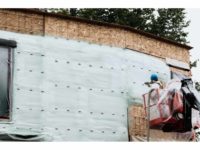SPF in Commercial Construction
Benefits of SPF in Commerical Applications














When it comes to usefulness, not many building materials can compare to spray polyurethane foam insulation. SPF is an ideal insulation material for builders and contractors when energy efficiency and code compliance related to air tightness and thermal performance are important, as this article explains.
Viable Commercial Uses
While much emphasis has been placed on improving energy efficiency, indoor air quality and structural durability in the residential construction market, the benefits of SPF in the commercial construction market should not be overlooked.
Today, builders, engineers and architects are increasingly selecting SPF insulation in commercial buildings because it can improve building durability, structural strength and resistance to water and moisture.
Commercial buildings have unique needs that are different than typical single-family or multi-unit residential structures. Heavy usage by retail clients, high turnover of occupants, large utility costs and liability concerns related to structural integrity can impact the economic viability of the commercial building. A better-built structure that has superior durability and reduced operating costs is highly attractive to owners and occupants of commercial spaces.
Why General Contractors Are Using SPF
Time is money for the general contractor, and project delays, cost overruns or long punch-lists can quickly turn a profitable project into a financial loss. When watching the budget of a commercial building project, the general contractor may select SPF because it reduces construction time and initial building costs by:
- Reducing the HVAC tonnage requirements
- Reducing the number of materials and trades required to construct the wall assembly—closed cell SPF can function as the all-in-one insulation material, air control layer and water barrier
Because general contractors are financially responsible for bringing projects to completion on time and on budget, selecting SPF offers a solution that will help them meet or beat their deadlines.
Building Types That Benefit From SPF
In commercial buildings, a well-designed and properly installed air barrier assembly can result in an even greater energy savings potential. According to simulations by the National Institute of Standards and Technology, air barrier systems in commercial buildings are estimated to reduce air leakage by up to 83 percent and can reduce natural gas consumption by more than 40 percent and electrical use by more than 25 percent.
Although SPF can provide benefits to all styles of commercial buildings, there are several types where SPF can provide exceptional value, including:
- School and educational facilities
- Healthcare facilities
- Offices
- Hotels
Exterior and Interior Applications
When applied to the exterior of commercial buildings in either new or retrofit situations, SPF can greatly reduce energy use, air infiltration and water intrusion. The two primary areas where SPF is used on the exterior of buildings are walls and roofing applications. When installed on the interior of walls or as part of the floor system, SPF is an integral part of the overall design strategy to improve comfort, indoor air quality and durability, and to reduce energy bills. Walls can be sources of air infiltration, especially in industrial settings, and have the potential of water intrusion, especially in the form of vapor. SPF in these areas can help promote a healthier and more durable space for the occupants.
SPF can be used as part of a roofing system, applied directly on the existing roof structure. It provides two important benefits to a building through waterproofing and increased insulation value. In new construction, it is ideal for flat commercial roofs because it is lightweight, durable and requires less maintenance compared to traditional roofing systems. Additionally, as a roofing material, SPF also increases the structural strength of the building by providing wind uplift resistance which can be critical in hurricane-prone regions.
Overall Energy Savings When Using SPF
The financial benefits of using SPF in commercial construction are primarily recognized in two specific areas: overall construction cost savings and annual savings through energy conservation. Other financial benefits of selecting SPF as an air control layer and insulation material include increased productivity through a more comfortable work environment, improved air quality, and the increased property value of a more durable and energy efficient building. Buildings insulated with SPF typically require less energy to heat and cool.
Reduced Construction Costs with SPF
For the builder or general contractor associated with new or retrofit construction, SPF can offer financial value to a project through the reduction in time, materials and number of trades. Because SPF can act as an air control layer and thermal control layer, fewer trades or subcontractors are needed to complete a project. This can be especially important in areas experiencing a high volume of construction starts. Finding qualified subcontractors who are skilled in proper installation of air barrier systems and insulation can be a challenge for a builder or general contractor. Scheduling the preferred trades can be difficult and delay the project while waiting for preferred installers to be available. Reducing the number of trades required to complete a project not only reduces the number of days the project takes to complete, but also reduces the likelihood of delays due to scheduling challenges.
Finally, SPF is often more economical for builders and contractors because it can be installed faster and easier than other air barrier and insulation materials. Using more traditional insulation materials and air sealing techniques would require several passes over the same area to install each separate component of the building envelope. Each time an area is revisited, whether for installing air barriers or insulation or for air sealing cracks, seams and voids, it lengthens the overall building schedule of the project. In contrast, installation of SPF only requires a single installation to manage air infiltration, the thermal boundary and air tightness.
Sustainable Building Practices and SPF
As a building material, SPF can contribute to credits or points for programs like LEED, Green Globes and NAHB National Green Building Standards in the following sections:
- Energy and atmosphere
- Sustainable sites
- Material and resource
- Indoor environmental quality
- Innovation in design
From an energy savings standpoint, SPF is on the front line of conservation of natural resources and reducing greenhouse gasses. Buildings are the largest user of energy in the U.S. today. According to the U.S. DOE, buildings account for more than 40 percent of all energy used in the U.S. annually, and over 40 percent of that energy is used for heating and cooling. Based on current building stock, though, up to 30 percent of the energy used to heat and cool buildings is lost through the building envelope as a result of inefficient air barriers and poor insulation levels.
Conclusion
Whether the objective is to increase energy efficiency, meet or beat sustainability goals, provide acoustic insulation, create a superior air control layer or improve structural integrity in high wind areas, SPF is a proven asset to any builder’s path to success. By matching the needs of the structure with the performance attributes of SPF, almost any new or existing commercial building can benefit from SPF.
To receive a copy of the white paper “The Benefits of Spray Polyurethane Foam in Commercial Applications,” contact sprayfoam@huntsman.com.
1MM reviews the sustainability characteristics of SPF roofing and insulations systems by Mason Knowles, published on Greenbuildingsolutions.org
Disclaimer
While all the information in this publication is to the best of our knowledge, accurate at the date of publication, nothing herein is to be construed as a warranty, expressed or otherwise. In all cases, it is the responsibility of the user to determine the applicability of such information and the suitability of any products for its own particular purpose. The sale of products referred to in this publication is subject to the general terms and conditions of sale of Huntsman International LLC or of its affiliated companies.
When it comes to usefulness, not many building materials can compare to spray polyurethane foam insulation. SPF is an ideal insulation material for builders and contractors when energy efficiency and code compliance related to air tightness and thermal performance are important, as this article explains.
Viable Commercial Uses
While much emphasis has been placed on improving energy efficiency, indoor air quality and structural durability in the residential construction market, the benefits of SPF in the commercial construction market should not be overlooked.
Today, builders, engineers and architects are increasingly selecting SPF insulation in commercial buildings because it can improve building durability, structural strength and resistance to water and moisture.
Commercial buildings have unique needs that are different than typical single-family or multi-unit residential structures. Heavy usage by retail clients, high turnover of occupants, large utility costs and liability concerns related to structural integrity can impact the economic viability of the commercial building. A better-built structure that has superior durability and reduced operating costs is highly attractive to owners and occupants of commercial spaces.
Why General Contractors
Are Using SPF
Time is money for the general contractor, and project delays, cost overruns or long punch-lists can quickly turn a profitable project into a financial loss. When watching the budget of a commercial building project, the general contractor may select SPF because it reduces construction time and initial building costs by:
Reducing the HVAC tonnage requirements
Reducing the number of materials and trades required to construct the wall assembly—closed cell SPF can function as the all-in-one insulation material, air control layer and water barrier
Because general contractors are financially responsible for bringing projects to completion on time and on budget, selecting SPF offers a solution that will help them meet or beat their deadlines.
Building Types That Benefit From SPF
In commercial buildings, a well-designed and properly installed air barrier assembly can result in an even greater energy savings potential. According to simulations by the National Institute of Standards and Technology, air barrier systems in commercial buildings are estimated to reduce air leakage by up to 83 percent and can reduce natural gas consumption by more than 40 percent and electrical use by more than 25 percent.
Although SPF can provide benefits to all styles of commercial buildings, there are several types where SPF can provide exceptional value, including:
School and educational facilities
Healthcare facilities
Offices
Hotels
Exterior and Interior Applications
When applied to the exterior of commercial buildings in either new or retrofit situations, SPF can greatly reduce energy use, air infiltration and water intrusion. The two primary areas where SPF is used on the exterior of buildings are walls and roofing applications. When installed on the interior of walls or as part of the floor system, SPF is an integral part of the overall design strategy to improve comfort, indoor air quality and durability, and to reduce energy bills. Walls can be sources of air infiltration, especially in industrial settings, and have the potential of water intrusion, especially in the form of vapor. SPF in these areas can help promote a healthier and more durable space for the occupants.
SPF can be used as part of a roofing system, applied directly on the existing roof structure. It provides two important benefits to a building through waterproofing and increased insulation value. In new construction, it is ideal for flat commercial roofs because it is lightweight, durable and requires less maintenance compared to traditional roofing systems. Additionally, as a roofing material, SPF also increases the structural strength of the building by providing wind uplift resistance which can be critical in hurricane-prone regions.
Overall Energy Savings When Using SPF
The financial benefits of using SPF in commercial construction are primarily recognized in two specific areas: overall construction cost savings and annual savings through energy conservation. Other financial benefits of selecting SPF as an air control layer and insulation material include increased productivity through a more comfortable work environment, improved air quality, and the increased property value of a more durable and energy efficient building. Buildings insulated with SPF typically require less energy to heat and cool.
Reduced Construction Costs with SPF
For the builder or general contractor associated with new or retrofit construction, SPF can offer financial value to a project through the reduction in time, materials and number of trades. Because SPF can act as an air control layer and thermal control layer, fewer trades or subcontractors are needed to complete a project. This can be especially important in areas experiencing a high volume of construction starts. Finding qualified subcontractors who are skilled in proper installation of air barrier systems and insulation can be a challenge for a builder or general contractor. Scheduling the preferred trades can be difficult and delay the project while waiting for preferred installers to be available. Reducing the number of trades required to complete a project not only reduces the number of days the project takes to complete, but also reduces the likelihood of delays due to scheduling challenges.
Finally, SPF is often more economical for builders and contractors because it can be installed faster and easier than other air barrier and insulation materials. Using more traditional insulation materials and air sealing techniques would require several passes over the same area to install each separate component of the building envelope. Each time an area is revisited, whether for installing air barriers or insulation or for air sealing cracks, seams and voids, it lengthens the overall building schedule of the project. In contrast, installation of SPF only requires a single installation to manage air infiltration, the thermal boundary and air tightness.
Sustainable Building Practices and SPF
As a building material, SPF can contribute to credits or points for programs like LEED, Green Globes and NAHB National Green Building Standards in the following sections:
Energy and atmosphere
Sustainable sites
Material and resource
Indoor environmental quality
Innovation in design
From an energy savings standpoint, SPF is on the front line of conservation of natural resources and reducing greenhouse gasses. Buildings are the largest user of energy in the U.S. today. According to the U.S. DOE, buildings account for more than 40 percent of all energy used in the U.S. annually, and over 40 percent of that energy is used for heating and cooling. Based on current building stock, though, up to 30 percent of the energy used to heat and cool buildings is lost through the building envelope as a result of inefficient air barriers and poor insulation levels.
Conclusion
Whether the objective is to increase energy efficiency, meet or beat sustainability goals, provide acoustic insulation, create a superior air control layer or improve structural integrity in high wind areas, SPF is a proven asset to any builder’s path to success. By matching the needs of the structure with the performance attributes of SPF, almost any new or existing commercial building can benefit from SPF.
To receive a copy of the white paper “The Benefits of Spray Polyurethane Foam in Commercial Applications,” contact sprayfoam@huntsman.com.
1MM reviews the sustainability characteristics of SPF roofing and insulations systems by Mason Knowles, published on Greenbuildingsolutions.org
Disclaimer
While all the information in this publication is to the best of our knowledge, accurate at the date of publication, nothing herein is to be construed as a warranty, expressed or otherwise. In all cases, it is the responsibility of the user to determine the applicability of such information and the suitability of any products for its own particular purpose. The sale of products referred to in this publication is subject to the general terms and conditions of sale of Huntsman International LLC or of its affiliated companies. W&C
Looking for a reprint of this article?
From high-res PDFs to custom plaques, order your copy today!












